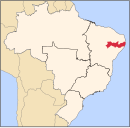8°58′52″S 38°13′13″W / 8.981223°S 38.2202339°W

Petrolândia (Petroland, named in honour of Dom Pedro II) is a municipality in the state of Pernambuco, Brazil. It is in the São Francisco Region. Petrolândia has a total area of 1056.6 square kilometers and had an estimated population of 36,901 inhabitants in 2020 according to the IBGE.[1] It has one of the largest GDP per capita of Sertão due to the location of one hydroelectric power plant, property of CHESF.
Languages
[edit]The Kambiwá language, now extinct, was spoken in the village of Barreira in Petrolândia.[2]
Geography
[edit]- State - Pernambuco
- Region - São Francisco Region
- Boundaries - Floresta (N), Jatobá (S), Tacaratu (E) and Bahia state (W)
- Area - 1056.6 km2
- Elevation - 282 m
- Hydrography - Moxotó River, tributary of São Francisco River
- Vegetation - Caatinga hiperxerofila
- Climate - semi-arid hot
- Annual average temperature - 25.7 c
- Main road - BR 232, BR BR 110, BR 316
- Distance to Recife - 430 km
Economy
[edit]The main economic activities in Petrolândia are based in commerce, energy and transportation industry, plus primary sector especially fruits such as coconuts, bananas, goiaba; and creations of goats, sheep, bulls and chickens. The energy sector due to the presence of Chesf is the most important activity.
Transport
[edit]From 1881 to 1964 Petrolândia was the terminus of a single track railway, known as the Estrada de Ferro Paulo Afonso. This railway was constructed to bypass rapids and waterfalls on the São Francisco River by linking the upper limit of navigation of the Lower São Francisco at Piranhas, with the lower limit of navigation of the Upper São Francisco at Petrolândia.
Indicators
[edit]Economic Indicators
[edit]| Population | GDP x(1000 R$).[3] | GDP pc (R$) | PE |
|---|---|---|---|
| 32.568 | 510.512 | 16.685 | 0.84% |
Economy by Sector 2006
| Primary sector | Secondary sector | Service sector |
|---|---|---|
| 3.50% | 73.73% | 22.77% |
Health Indicators
[edit]| HDI (2000) | Hospitals (2007) | Hospitals beds (2007) | Children's Mortality every 1000 (2005) |
|---|---|---|---|
| 0.688 | 1 | 58 | 16.3 |
References
[edit]- ^ IBGE 2020
- ^ Meader, Robert E. (1978). Indios do Nordeste: Levantamento sobre os remanescentes tribais do nordeste brasileiro (in Portuguese). Brasilia: SIL International.
- ^ Petrolandia 2007 GDP IBGE page 32 Archived 2016-03-04 at the Wayback Machine
- ^ PE State site - City by city profile

Well, that’s interesting to know that Psilotum nudum are known as whisk ferns. Psilotum nudum is the commoner species of the two. While the P. flaccidum is a rare species and is found in the tropical islands. Both the species are usually epiphytic in habit and grow upon tree ferns. These species may also be terrestrial and grow in humus or in the crevices of the rocks.
View the detailed Guide of Psilotum nudum: Detailed Study Of Psilotum Nudum (Whisk Fern), Classification, Anatomy, Reproduction